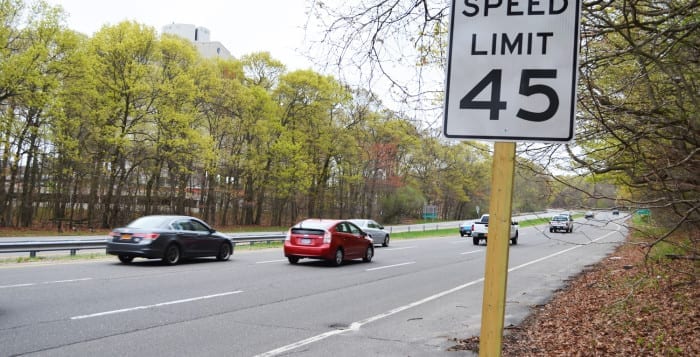Suffolk displays designs for rapid transit bus lanes on Nicolls
County Road 97, commonly known as Nicolls Road, is one of Long Island’s main thoroughfares, connecting Stony Brook on the North Shore to Patchogue on the South with nearly 16 miles of highway. For years the county has examined ideas to relieve rush hour traffic; now it is proposing a rapid-transit bus system, high-occupancy vehicle lanes and 16 roadside bus stops.
“It’s going to be dual function, and also reduce congestion on Nicolls Road, so its two birds, one stone effect,” said William Hillman, a chief engineer at Suffolk County’s Department of Public Works.
In a 2015 county report prepared by multinational engineering firm Parsons Brickerhoff, the project cost was originally estimated at upward of $200 million, though plans have been scaled down slightly since then.
“By making the buses faster, more reliable, more frequent, we may have a chance to get people to sit in it and get out of their cars.”
— Kara Hahn
Babylon-based engineering firm Greenman-Pedersen, which was the latest company tapped to research the Nicolls Road project, presented April 2 summaries of its initial plans at Suffolk County Community College.
The plans, as they currently exist, call for 16 new stations positioned along Nicolls as bus terminals connecting to existing Suffolk County Transit routes. The plans would also include 16.5 new miles of dedicated lanes to bypass traffic congestion. Service of these bus lines include a frequency much higher than any current county bus, from a weekday peak of every 10 minutes to a weekend peak of 20 minutes.
Presenters did not offer details on the buses’ fuel source nor did they describe where new stoplights or other traffic slowing devices may be implemented. Larry Penner, who worked for more than three decades in the Federal Transit Administration regional office and now comments on ongoing projects as a self-described transit historian, said that buses typically get right of way in among normal traffic.
Mike Colletta, a project engineer at engineering firm Greenman-Pedersen, which created the most recent presentation on the road, said the firm was recently put onto the project by Suffolk County, and is still in the very early stages of design.
County Legislator Kara Hahn (D-Setauket) said the Legislature has been approving the project, applying for grants and getting funding toward the corridor studies for years. The project still has a while to go before the county can estimate the true impact on traffic. County officials worry that people will not use buses.
“By making the buses faster, more reliable, more frequent, we may have a chance to get people to sit in it and get out of their cars,” Hahn said.
While representatives from the county and engineering firm could not give an estimate into the amount of vehicles, Penner said the county still has many things to consider, including costs of roughly 10 new buses, 16 stations and proposed amenities, such as real-time bus locators, similar to the units found at the train stations. Seating and overhangs for the stations themselves must also be factored in.
“Here’s the challenge they face: The density in Suffolk County is far less than Nassau, and far less than New York City,” Penner said. “How many people would drive to one of these 16 Bus Rapid Transit stations and how many people will take a commuter bus and switch to the rapid transit when you can get in your car and get there much more quickly, that will be the challenge they face, because time is money for people.”
These proposed stations would link up to existing Suffolk County Transit bus routes. Multiple existing bus routes already travel along or intersect with Nicolls, including the 3D, the S62, S69, 6B, S58 and 7A, though only two routes use the county road for a significant distance. Service on Suffolk County Transit has also been spotty for a long time, with users often left waiting for buses for over an hour.
Bruce Morrison, the president of the Selden Civic Association, said he is skeptical of the project, questioning how many people would use it, especially with existing issues on the regular county buses.
“If it’s not attractive to the public, you’re going to have empty buses.”
— Bruce Morrison
“Will they get the ridership?” Morrison said. “If it’s not attractive to the public, you’re going to have empty buses.”
Buses would operate in the HOV lanes on the inside of the road and along the specialized bus lanes along the outside portions of the road. One proposed route would take these buses down the Long Island Expressway, through the Ronkonkoma Train Station and the expected Ronkonkoma Hub project as well before linking back up to Nicolls.
County Executive Steve Bellone (D) has been touting his Connect LI plan for years. In 2014 the county started exploring several other possible projects. Expanding Route 110 and the Sagtikos Parkway is among the other options. In 2015, Bellone shared his expanded plans for $300 million bus transit plan to connect Long Island’s downtowns, colleges, research and business centers.
At one point, the county executive’s office floated the idea of building a rapid transit in the median of the well-populated road. Environmental impact studies are ongoing and necessary to ultimately receive federal funding.
In addition to the new route, engineers are also touting designs for a new trail that could run parallel to Nicolls. This path would be akin to the Rails to Trails project, but unlike the 3-mile Greenway Trail from Setauket to Port Jefferson Station, and the upcoming 10-mile project from Wading River through Mount Sinai, this path could be well over 15 miles of trail, crossing under the LIE and over other high trafficked roads like Middle Country Road. The 2015 study allocated $15 million for the biking and hiking trail.







